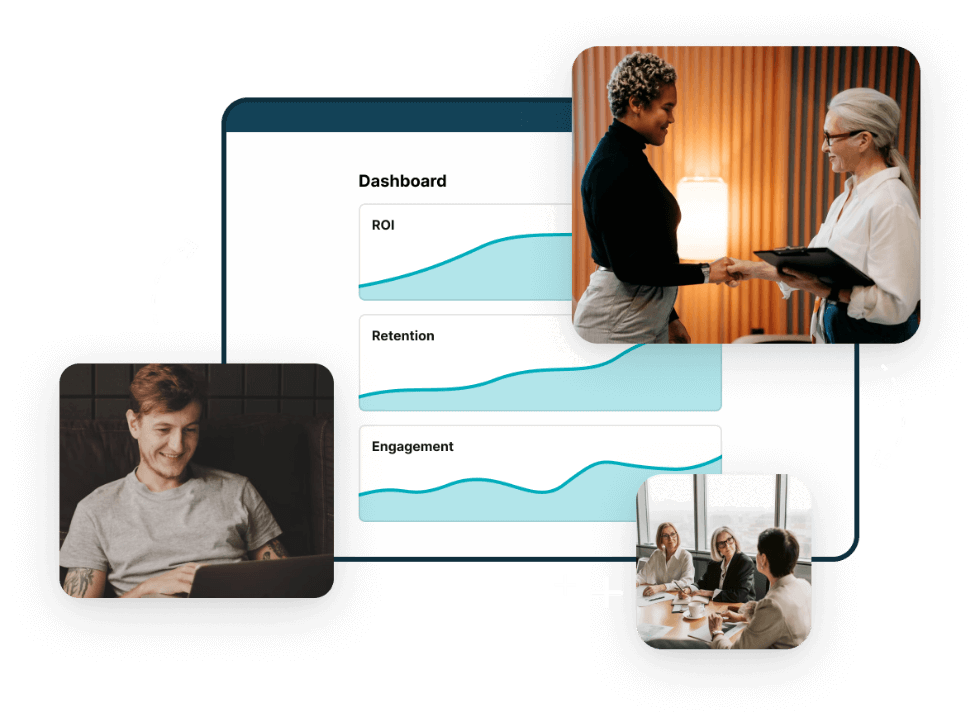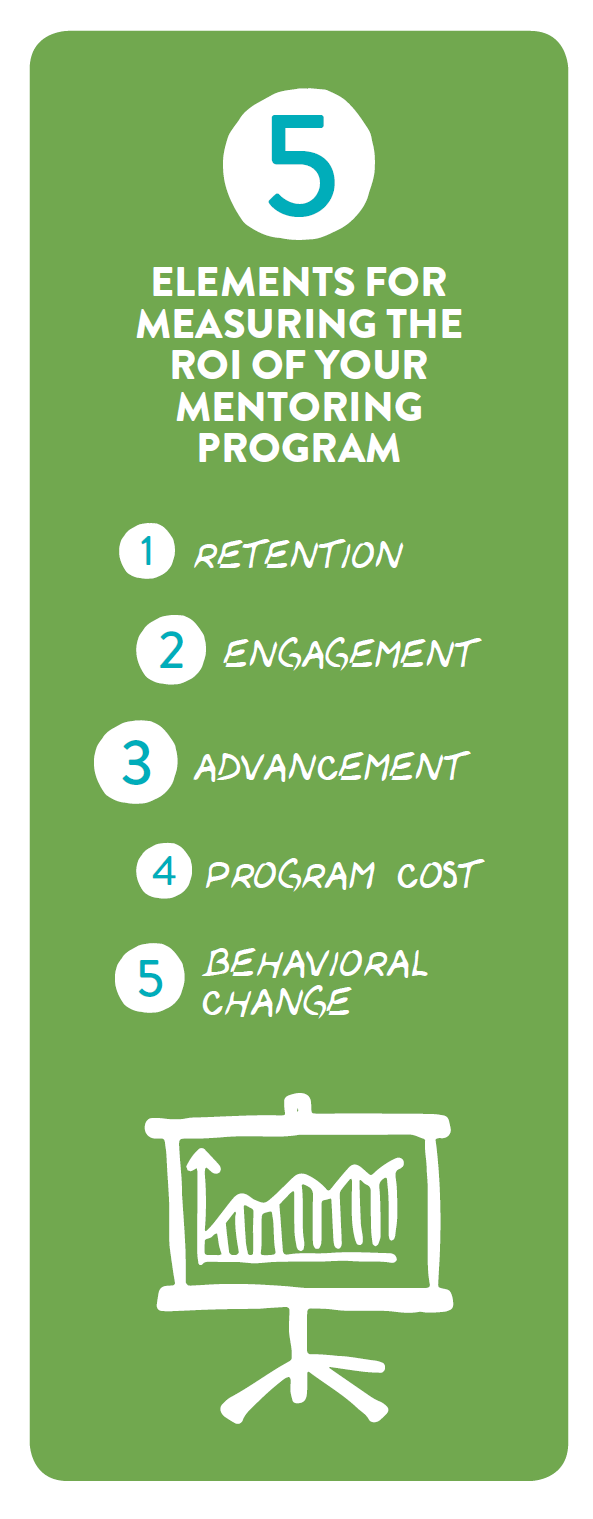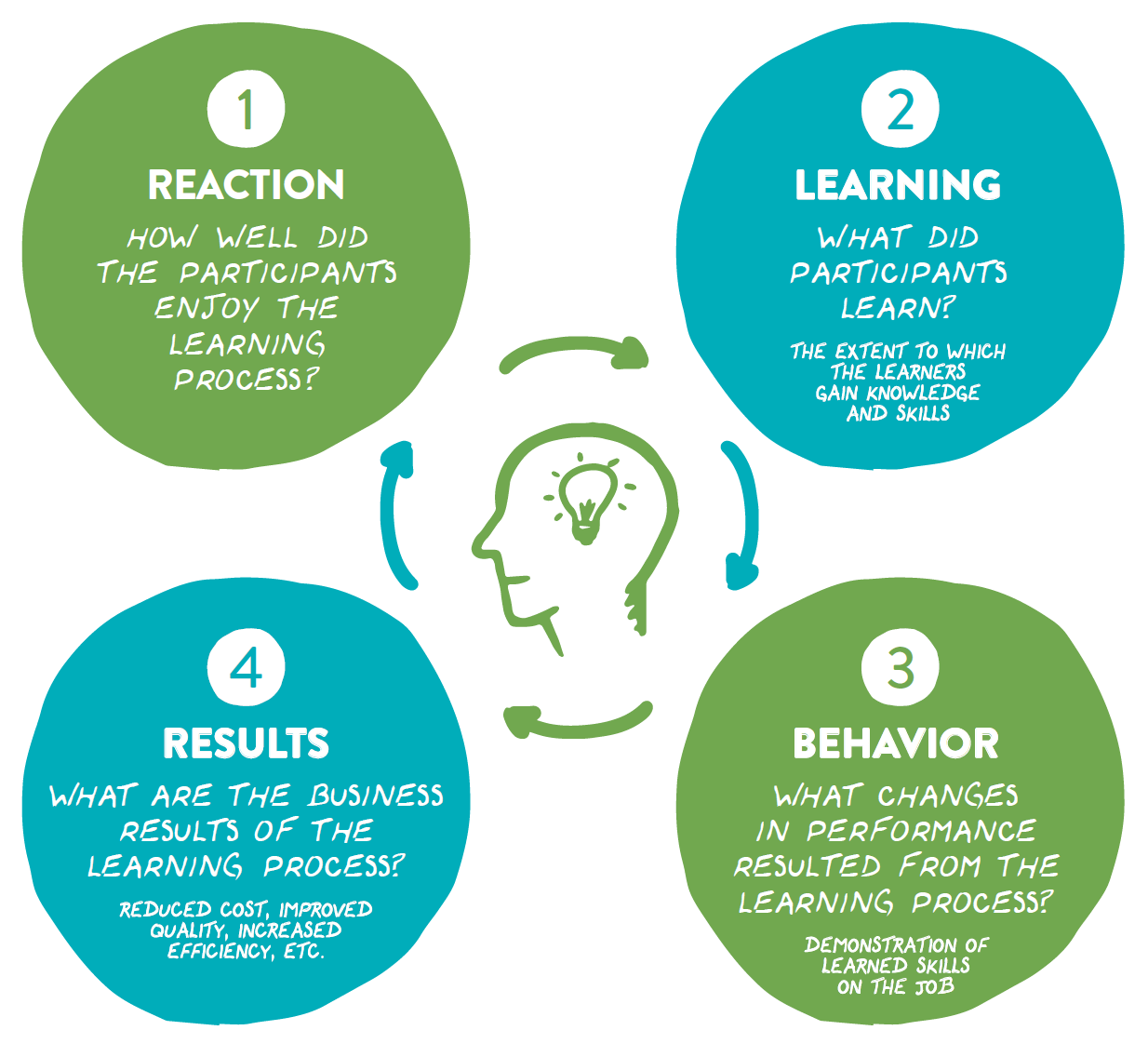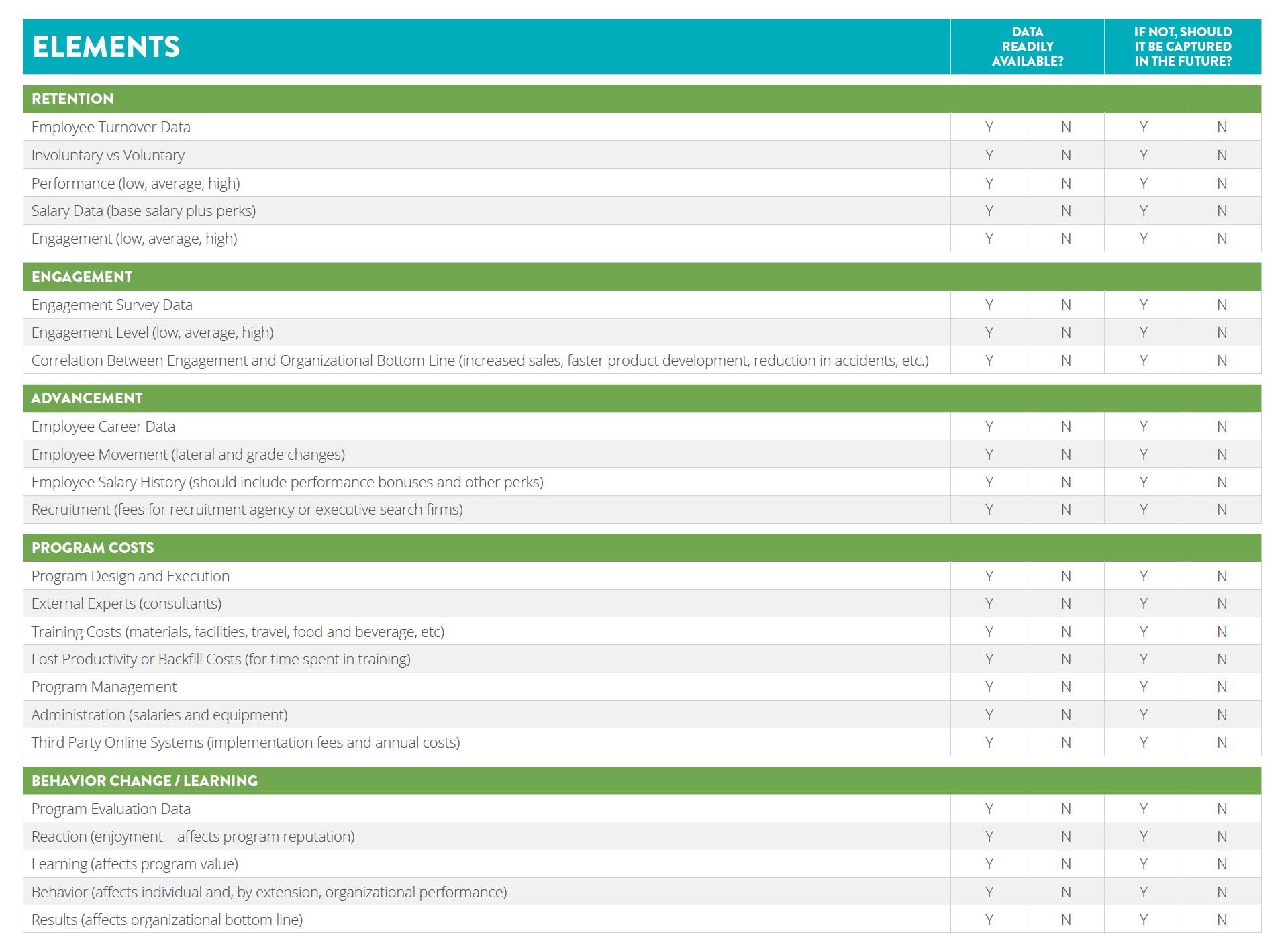The ROI of Mentoring
How to increase productivity, retention & profit
with formal mentoring programs

It’s no secret that organizations who invest in employees are top performers. Programs like formal mentoring and coaching are increasingly popular methods for developing an organization’s talent pool. However, how do you know if these programs are effective in improving organizational performance? And how do you know if your investments are paying off?
We invite you to read this short guide to learn the important factors to consider in calculating your organization’s return on investment (ROI).
As a bonus, see the Readiness Checklist at the end to get your ROI calculation started!
Download ROI of Mentoring Ebook
The ROI Of Investing In Your Employees
Top performing organizations invest in their employees. This fact is borne out by reviewing the list of best companies over the past few years. Whether it’s Fortune’s “100 Best Companies to Work For” or Forbes’ “The World’ Best Employers,” Apple and Google (Alphabet) top the list—both companies well known for valuing employee development. But it doesn’t take the resources of these technology giants to reap immense gains from investing in the development of your employees, or as they are more descriptively termed, your organization’s talent.
There are a number of strategies for developing talent and most organizations engage in some of these activities. But effective organizations, what Deloitte terms high-impact learning organizations, invest in more than just the basics. They engage in focused development activities designed to advance individual and organizational performance. Some of the most effective activities are targeted mentoring and coaching.
Cox Automotive wanted to move employees through the talent pipeline, rather than risk them looking for opportunities outside of the company. The company developed a formal and structured career mentoring program to develop aimed at impacting employee retention and advancement. How did they know that the program had been a success? They defined clear metrics and conduct periodic evaluations.
In order to effectively evaluate the impact of your mentoring program, there are a number of factors to consider in measuring your organization’s return on investment (ROI).
Retention
Everyone knows that attrition costs organizations money. The are often summed up by the following:
- Hard costs associated with replacing an employee (off- boarding the previous employee and hiring the new employee)
- Softer transition costs (onboarding, knowledge transfer, lost productivity)
- More difficult to quantify (but essential to consider) costs of long-term disruption to the organization’s talent pipeline
One of the benefits of mentoring programs is to increase retention of targeted employees. To measure the impact of increased retention or reduced attrition, you can use the organizational cost of replacing an employee (as defined by your organization) multiplied by the overall change is attrition.
Remember to segment your employee population so you are only evaluating the change relative to the population you are targeting for your mentoring program. There are several methods for determining the cost of attrition. Perhaps the simplest is to calculate it based on the salary of the replaced employee. 150% of the base salary is the percentage most commonly cited).
The cost of replacing an individual employee can range from .5x to 2x the employee’s annual salary.
– Gallup
Download ROI of Mentoring Ebook
Engagement
Gone are the days that organizations measure only employee satisfaction. While satisfaction may correlate with retention, it doesn’t tell an organization anything about employee productivity or other drivers of business outcomes.
Having an effective mentoring program will positively impact employee engagement levels and organizational outcomes.
Enter employee engagement, a measure of the emotional commitment employees have to the work and their company. According to Gallup, more than 70% of employees are not engaged or actively disengaged in their workplace.
Without engagement, today’s companies are in a world of hurt. SHRM finds “not only does engagement have the potential to significantly affect employee retention, productivity and loyalty, it is also a key link to customer satisfaction, company reputation and overall stakeholder value.” Effectively, engaged employees drive strong organizational performance.
Based on extensive research, we know that a key driver of employee engagement is providing learning and development opportunities. Having an effective mentoring program will positively impact employee engagement levels and organizational outcomes.
But the key is evaluating the impact of this program by measuring its effect on employee engagement. When doing so, remember to segment your data so you can target your analysis to the population being developed.
Grow Your People With Mentoring Software
Advancement
Retention and advancement are highly correlated. People remain in organizations where they have an opportunity to learn and grow. Thus, investing in employee development provides organizations with a strong talent pipeline. Having a strong pipeline is increasingly critical as the availability of skilled workers continues to shrink. According to a Manpower Group study, nearly 4 in 5 employers globally report difficulty finding the skilled talent they need in 2023.
In creating a formal mentoring program focused on leadership development for employees, especially underrepresented employees, one large academic hospital found that mentoring contributed to participants being 17% more likely to have a change in department or job. Similarly, non-white participants were two times more likely to see a change in department or job compared to non-white, non-participants in the program.
When evaluating the impact of their company’s mentoring program on employee advancement, Sun Microsystems found that 25% of employees who took part in the company’s mentoring program had a salary grade change, while only 5% of employees who did not participate in the program had a similar change in grade. Additionally, mentors were promoted six times more often than those not in the program and mentees were promoted five times more often than those not in the program.
As evidence of the correlation between retention and advancement, the retention rates were much higher for mentees (72%) and mentors (69%) than for employees who did not participate in the mentoring program (49%).
Program Costs
Program costs are one of the most obvious elements of calculating a program’s return on investment. However, there are a variety of organizational practices regarding which costs are calculated. Most organizations factor in the hard program costs for:
- external consultants
- materials
- expenses such as travel
- food and beverage
- and beyond
But what about the other expenses incurred by an organization? The cost of administering a large program can be considerable.
When looking at organizational spending on learning and development, Training Magazine found that U.S. training expenditures passed the $100 billion-mark for the first time, as reported in its 2022 Industry Report.
While increased organizational investment in employees is good news, the value as well as the cost needs to be considered. Increasingly, organizations are looking to technology to lessen costs while providing greater value.
Online and virtual learning solutions, such as mentoring platforms and social learning tools, support just-in- time learning while potentially reducing the administrative costs of development programs.
In reviewing learning and development trends across a number of US sectors, the report found that organizations are increasing spending on outside products and services to meet the growing demands of the workforce. Specifically, overall spending rose to $8.2 billion.
Regardless of delivery model being used for any talent development program, it is critical to consider both hard program costs and the softer costs of program management when factoring overall ROI.
Download ROI of Mentoring Ebook
Behavioral Change
Most organizations conduct some type of program evaluation to evaluate program effectiveness. Kirkpatrick’s well established Four Level Evaluation Model is frequently cited as the ideal. In Kirkpatrick’s model, program evaluation would consist of the following steps or levels:
Frequently organizations stop after level two, which is often a self reported learning indicator. While it is important to evaluate whether or not a participant learned a skill that the program was designed to teach, this level of evaluation does not tell an organization anything about what impact this knowledge has on individual or organization performance (behavior and results).
In order to begin to assess impact at this level, mentoring programs must be evaluated more longitudinally as individual and organizational behavior change takes time.
While initial learning measures are an important element in evaluating program success, a high impact learning organization is one that begins to gather data on behavior and impact to effectively calculate a mentoring program’s true ROI.
ROI Calculations
Using some of the elements outlined above, you could use the following simple calculation to determine a program’s return on investment.
For Example: If retention increased 5% (out of 100 employees) and the average salary for the population is $100,000 annually then R would equal $750,000 (5 x $150,000 – remembering that the cost to replace an employee is 1.5x his/her salary).
If employee surveys indicate engagement and/or advancement increased by 10% and, for example, the organization has determined that engaged employees increase sales by 25%, netting the organization an additional $1,000,000 in revenue annually, then E would equal $100,000 (.10 x $1,000,000).
To sum up this example, we have:
If your organization calculates separate advancement metrics and evaluation data for behavioral change and results (levels 3 and 4 of the program evaluation), you can add these elements into the sample calculation above.
Download ROI of Mentoring Ebook
Readiness Checklist
Below is a list of critical elements to effectively measuring the ROI of your mentoring program.
While it is not essential to have every element in place, it is valuable to know what is readily available. For those elements not in place, you should consider whether or not you want to put something in place to capture this data in the future.
Evaluation processes often become more sophisticated as programs mature. Additionally, the more effective your measurement process is, the more compelling your success story will be.
Building ROI with Mentoring Software
Showcasing the impact of mentoring isn’t hard, but it does take intention, effort and the right tools. Mentoring software helps you do this effectively and at scale. Using software makes mentoring’s ROI easy, putting the right metrics, reports and dashboards at your fingertips.
The Chronus platform makes measuring your mentoring program simple. Our customizable reports and program dashboards help you see improvements in satisfaction, engagement, retention and advancement sooner and more clearly. Chronus’ robust integrations with HRIS and people data systems allow you to see real-time outcomes of your program.
Look at an individual program or your entire mentoring strategy, and use that data to illustrate outcomes and impact to your stakeholders. Segment and configure data for actionable results to improve your mentoring impact over time with the help of essential reports such as:
- Retention Report
- Advancement Report
- Match Report
- Diversity Report
With software, your mentoring program can provide more employees with inclusive development opportunities and pathways, while reducing admin effort and time for your team. Let mentoring software help you tell your story bigger and better than before.
In Conclusion
The most successful organizations over time are high impact learning organizations. These organizations understand the value of mentoring, effectively evaluate program impact using the measurements listed above, and perhaps most importantly, share compelling mentoring success stories throughout the organization.
Once you conduct an effective ROI evaluation, it becomes easy to tell your organization’s mentoring success story. This level of strategic communications is a self-fulfilling prophecy, creating program sustainability and enduring organizational culture change.
Chronus mentoring software humanizes the employee experience, unleashing the potential of a company’s most valuable asset—its people. With unique MatchIQ® technology, a guided experience for participants, and themost configurable platform in the industry, we work with some of the top organizations, including PNC, Autodesk, Uber and more. Simplify the complexity of running a mentoring program by customizing the Chronus platform to easily launch, scale and fit your unique need.
Mentoring Software Can Help
Watch the video to see how the Chronus mentoring platform makes it easy to start, manage, and measure modern mentorship programs.
What Can You Achieve
with Chronus?
Software can drive 50% Increased Engagement. Learn how Chronus can impact your mentorship program.






